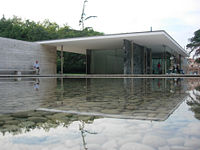Barcelona Pavilion: Difference between revisions
imported>Caesar Schinas m (Bot: Delinking years) |
imported>Meg Taylor (update template, move content to subgroups) |
||
| Line 10: | Line 10: | ||
==Citations== | ==Citations== | ||
{{reflist}} | |||
Latest revision as of 18:34, 14 September 2013
The Barcelona Pavilion, was the German Pavilion for the 1929 International Exposition in Barcelona, Spain. It was designed by the German modernist architect, Ludwig Mies van der Rohe and was constructed in 1928 but demolished after the exposition in 1930. It is widely considered to successfully embody many of the ideas of early modernist architecture and such was the impact and importance of the pavilion on architectural history and theory, it was reconstructed to the original design on the same site from 1983-86.[1]
Mies van der Rohe, in part expanding on ideas of neoplasticism originally developed by the Dutch De Stijl group, realised a supreme example of the free plan by supporting the dramatically cantilevered flat concrete roof on 8 cruciform steel columns. This freed the partitions to concentrate on the subdivision of space rather than performing the more usual perfunctory task of both subdivision and structural support. The resulting organisation of the partitions intends to achieve a blurring of the usual hard boundary between inside and outside, a technique often called the 'etherealisation' of architecture, further emphasised by the pleasing distribution of perpendicular planes which allow space to flow around them and the apparently 'floating' roof.
Entirely free from decoration, beauty is achieved through, the massing of the building, the exquisite minimalist detailing and selection of sumptous materials such as marble and travertine for their grain and texture. The building surmounts a raised platform and is located besides a large reflecting pool. A smaller building is located to one side of the pool at the other end of the platform.
The famous Barcelona chair was also designed by Mies specifically for the pavilion.
